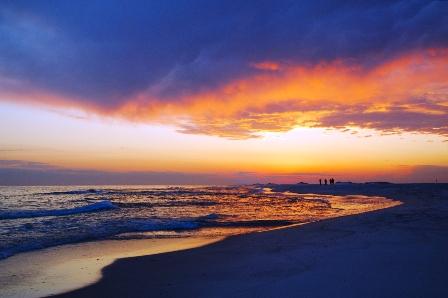Hordes of day-trippers are once again converging on the Fort Pickens area of Gulf Islands National Seashore. Though not quite healed from its hurricane pummelings, this popular sun-sea-sand destination is very much back in business.
The seashore’s Fort Pickens area (called simply Fort Pickens) consists of the westernmost seven miles of 52-mile long Santa Rosa Island near Pensacola, Florida. This end of the island takes its name from historic Fort Pickens, which was completed in 1834 as the largest of four coastal forts defending Pensacola Bay. Tours of the restored fort are available in season.
The really neat thing about the Fort Pickens area is that the beachfront environment has remained pretty much in its natural state and is very attractive. Now protected as part of the National Seashore, the Fort Pickens beachfront has always been too storm-vulnerable to develop in the densely built up manner of beaches resorts elsewhere.
The Fort Pickens area is, by any reasonable measure, a great place for fun at the shore. Stretching back from the water’s edge is an attractive profile of white sugar-sand beaches, dunes, and thick vegetation with woods and swamps. Watchable wildlife abounds. A trail for hiking and biking wends its way through the park. There is a campground, several fine beaches for swimming and surfing, a picnic pavilion, a fishing pier, and a jetty offering pretty good scuba diving.
All of this is designed to be automobile-accessible, too. Small wonder that Fort Pickens is one of the Pensacola/Pensacola Beach vicinity’s prime beachfront attractions. Some have gone so far as to call it the area’s “crown jewel.”
You can imagine the consternation when the Fort Pickens area was thrashed by a succession of damaging storms, including Hurricane Ivan in 2004 and Tropical Storm Arlene, Hurricane Cindy, and Hurricane Dennis in 2005. Storm surges, fierce winds, hurled debris, and wind-driven salt spray combined to scour the beaches, wash out the main road, flatten the towering dunes, kill or mutilate trees by the hundreds, and litter the landscape with wreckage. The campground, alas, lost nearly all of its shade trees. Trail segments and access roads were obliterated. If Fort Pickens were a boxer it would have had to take a standing TKO.
There was nothing the Park Service could do with the Fort Pickens area but close it down for repairs. And so many thousands of people who had made Fort Pickens day-trips a treasured part of their lifestyle were left to mark time for several years.
What mattered most to the multitude was the restoration of vehicular access. Whatever the condition of the place, you had to be able to get there. The closure of the main access road, Fort Pickens Road (J. Earle Bowden Way), left hiking, biking, and boating as the only means of access.
Now, thank goodness, people are able to get there again in their family cars and RVs. A major event was the reopening of the key road segment stretching between Navarre Beach (eastern entrance of the park) and popular Opal Beach. That happened at 7:00 a.m. on Friday, May 22, the first day of the long Memorial Day weekend. Vehicles bearing upwards of 15,000 park visitors poured down the newly-opened road and delivered happy sunbathers, swimmers, surfers, and picnickers to the beach. Additional road improvements are in progress, with the link to Pensacola Beach (far to the west) still needing work.
Seashore superintendent Jerry Eubanks is happy to see visitors enjoying themselves at the park, but warns that not all facilities and services have been restored. The campground, a key facility, is basically suitable only for primitive camping or self-contained RVs. Electricity won’t be fully restored until September, no water is available, campsites lack shade trees, and the campground store won’t open at all this season. The hiking/biking trail that runs through the middle of the park still has no access road, and even though encroaching vegetation has been cleared (thanks to Florida Trail Association volunteers), some segments remain quite rough. There is still a good bit of wreckage and litter in the park.
If you plan to visit the Fort Pickens area, by all means visit this site first. It provides an updated NPS handout (dated May 21, 2009) with vital information about current conditions and restrictions.
One key restriction is a 15 mph speed limit –that’s right, fifteen miles per hour – all the way from the Navarre Beach entrance to the Ranger Station. This reduction of the normal 35 mph speed limit is necessary to protect shorebirds that are nesting right next to the roadway. Motorists are also warned that work crews and heavy equipment may be encountered throughout the park this summer.
Postscript: The Seashore will officially reopen the Fort Pickens area with a ribbon-cutting ceremony scheduled for 10:00 a.m. Tuesday, June 2, at the Fort Pickens Road entrance. The public is invited, and parking is available at the gate a short distance from the ceremony site.


 Support Essential Coverage of Essential Places
Support Essential Coverage of Essential Places






